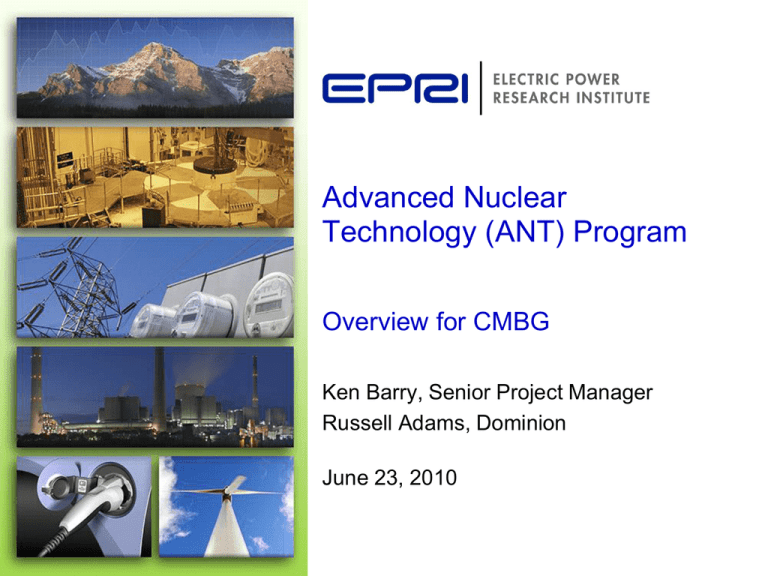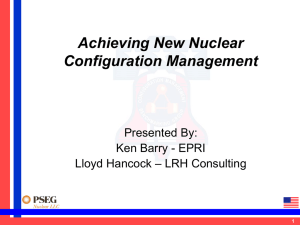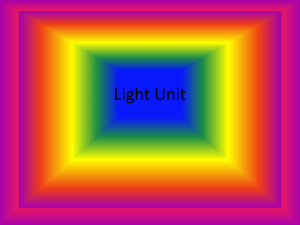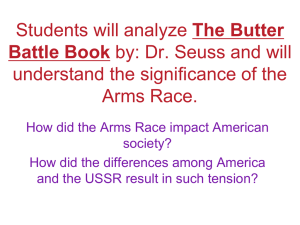
Advanced Nuclear
Technology (ANT) Program
Overview for CMBG
Ken Barry, Senior Project Manager
Russell Adams, Dominion
June 23, 2010
© 2008
2010 Electric Power Research Institute, Inc. All rights reserved.
2
EPRI Portfolio Spans the Entire Electricity Sector
Generation
Advanced Coal Plants,
Carbon Capture and
Storage
Material
Degradation/Aging
Fuel Reliability
Combustion Turbines
Environmental Controls
High-Level Waste and
Spent Fuel
Management
Generation Planning
Major Component
Reliability
Operations and
Maintenance
Renewables
© 2008
2010 Electric Power Research Institute, Inc. All rights reserved.
Power Delivery &
Utilization
Distribution
Air Quality
Energy Utilization
Global Climate Change
Grid Operations and
Planning
Land and Groundwater
Substations and Asset
Planning
Occupational Health
and Safety
Transmission and
Increased Power Flow
T&D Environmental
Issues
Water and Ecosystems
Nuclear Power
Nondestructive
Evaluation and Material
Characterization
Equipment Reliability
Instrumentation and
Control
Risk and Safety
Management
Advanced Nuclear
Technology
Low-Level Waste and
Radiation Management
3
Environment
Advanced Nuclear Technology
Program Objectives
• New nuclear power plants must overcome a number of regulatory, economic,
technical, and social challenges prior to becoming a reality
• Program efforts focused around:
–
–
–
–
–
Facilitating standardization across the new fleet
Transferring technology to new plant designs
Ensuring top plant performance from start of operations
Reduce overall deployment risk and uncertainty
Supporting development of advanced nuclear plants and associated
strategic initiatives
© 2010 Electric Power Research Institute, Inc. All rights reserved.
4
EPRI’s Response …The ANT Program
Advanced Nuclear
Technology (ANT)
Program
Materials and Fuels Research
Maintenance Optimization
Seismic/NDE/Cooling Technologies
Current Plant
Technology
Strategic Initiatives
Near-Term
Deployment of ALWRs
Technology Transfer/Lessons Learned
Technology Assessment (URD)
New Plant Materials
Seismic Issues Resolution
New Plant Equipment Reliability
Non-Destructive Evaluation Initiatives
NPP Cooling Water Utilization
Fusion Energy Assessments
Integrated Spent Fuel Management
Advanced Nuclear
Plants
Next Generation Nuclear Plant (NGNP)
Small Modular Reactors (SMRs)
Advanced Reactor Concepts
© 2010 Electric Power Research Institute, Inc. All rights reserved.
5
EPRI’s ANT Program Website
http://www.epri.com/ant
© 2010 Electric Power Research Institute, Inc. All rights reserved.
6
2010 ANT Membership Breakdown
Current 2010 Membership…$4.225M
2010 Potential…
© 2010 Electric Power Research Institute, Inc. All rights reserved.
7
2008 ANT Projects
Project
ID#
Project Title
EPRI Project
Manager
Executive Sponsor
2008-01
NDE Risk-Informed PSI & ISI
Methodology
Pat O’Regan
Joe Turnage (CEG)
2008-02*
New Plant Procurement Specifications
Marc Tannenbaum
Gene Grecheck (DOM)
2008-03
New Plant Welding and Fabrication
Guidelines
Steve McCracken
Jack Bailey (TVA)
2008-04
CEUS Seismic Sources
Characterization Project
Bob Kassawara
Doug McComb (SNC)
2008-05
Materials Management Matrix (MMM)
Jeffrey Hamel
Steve Blossom (STP)
2008-06
NDE and Reduction of Repairs in
Nuclear Construction (ASME Sect III)
Steve Swilley
Dave Lewis (PSEG)
2008-07
Equipment Reliability for New Plants
Leonard Loflin
Scott Bond (AmerenUE)
2008-08*
Margins and Monitoring Project Phase
III
Tom Turek
Bryan Dolan (Duke)
2008-09*
URD Update, Revision 10
Jeffrey Hamel
Marilyn Kray (Exelon)
* Projects completed
© 2010 Electric Power Research Institute, Inc. All rights reserved.
8
2009 ANT Projects
Project
ID#
EPRI
Project
Manager
Project Title
Executive
Sponsor
2009-01
Achieving New Nuclear Virtual Plant Configuration
Management
Ken Barry
Gene Grecheck
(DOM)
2009-02*
Modular Equipment Testing, Shipping and Storage Benchmarking and Guidelines
Ken Barry
Brad Stokes
(SCE&G)
2009-04
Guidance on EMI Protection for Instrumentation and
Control Systems
Ken Barry
Doug McComb
(Southern)
2009-05*
EPRI Fuel Reliability Guidelines Assessment –
Implications for New Plants
Kurt Edsinger
Brad Stokes
(SCE&G)
2009-07
Next-Generation Attenuation (NGA) Model
Development for Central and Eastern United States
(NGA-East)
Jeffrey Hamel
Doug McComb
(Southern)
2009-08
Safety Related Stationary Battery Qualification
Wayne
Johnson
Doug McComb
(Southern)
2009-09
EUR/URD Comparison Project
Jeffrey Hamel
Pablo Lopez
(ENDESA)
* Projects completed
© 2010 Electric Power Research Institute, Inc. All rights reserved.
9
2010 ANT Projects
Project
ID#
Project Title
EPRI
Project
Manager
2010-01
Alloys 690/52/152 PWSCC Research for New Plants
Al Ahluwalia
Joe Turnage
(Constellation)
2010-02
Digital RT
Steve Swilley
David Lewis
(PSE&G)
2010-03
New Plant Startup Program Guidelines
Ken Barry
Brad Stokes
(SCE&G)
2010-04
Water Chemistry Guidelines Assessment for New
Nuclear Power Plants
Keith Fruzetti
Marilyn Kray
(Exelon)
2010-05
NDE Digital Data
Steve Swilley
2010-06
Ferritic Stainless Steel Testing
Steve Swilley
2010-07
Digital I&C Training
Ray Torok
Doug McComb
(Southern)
2010-08
HFE Training
Joe Naser
Doug McComb
(Southern)
© 2010 Electric Power Research Institute, Inc. All rights reserved.
10
Executive
Sponsor
2010 ANT Projects
Project
ID#
Project Title
EPRI
Project
Manager
2010-09
Impaction of Radionuclide/Source Term
Ken Barry
2010-10
Concrete Sensors
Steve Swilley
2010-11
Methodology for Risk Informed Procurement
Pat O’Regan
2010-12
Technical Basis for HDPE Above-Ground Use
Doug Munson
2010-13
SACTI Update
Jeffrey Hamel
© 2010 Electric Power Research Institute, Inc. All rights reserved.
11
Executive
Sponsor
Curtis Warner
(Arkansas)
Gene Grecheck
(Dominion)
2011 Candidate ANT Projects
Project ID#
Project Title
2010-15
BWRVIA Assessment for ABWR
2010-12
FME Guidelines for Nuclear Construction
2010-03
Cooling Tower Guidelines for New Plants
A
Double-walled HDPE Piping Evaluation
B
EPRI Groundwater Protection Guidelines for New Nuclear
Power Plants
C
Changes to IEEE 535 to support Passive Plant Stationary
Battery Qualification
D
Guidelines for crediting self testing to replace tech. spec.
surveillances
E
Methodology for set point determination on commercial
instruments
F
NDE Techniques for Concrete Void Detection and Sizing
© 2010 Electric Power Research Institute, Inc. All rights reserved.
12
2011 Candidate ANT Projects
Project ID#
Project Title
G
Utility Requirements Document Update Project
H
Site Specific Sampling Methods for Latent Debris
I
Quality Assurance Program for 2D and 3D Design and Modeling
Software and V&V for Quality Software
J
Passive Heat Exchanger Thermal Performance
K
Combinatorial Testing on new plant digital I&C designs
L
Reduced Accident Source Term
M
Reconciliation of International Codes for Procurement
N
Seismic Base Isolation Guidelines for Critical Structures
© 2010 Electric Power Research Institute, Inc. All rights reserved.
13
2011 Candidate ANT Projects
Project ID#
Project Title
O
Equipment Qualification (EQ) Review for New Plant Designs
P
Environmental Fatigue for New Plant Designs
Q
Design Reliability Assurance Program (D-RAP) Implementation
R
High Strength Rebar use in Nuclear Power Plants
S
Materials Management Matrix Projects for SMRs (NuScale and
mPower Designs)
T
PDI Evaluation of the Compatibility of New Plant Configurations
with Existing Qualification Sample Sets
© 2010 Electric Power Research Institute, Inc. All rights reserved.
14
2009-01 Achieving New Nuclear Virtual Plant
Configuration Management
Project Goal
• We need a common data language and
interoperability standard that will be used by the
nuclear plant sub-tier suppliers through the
suppliers, through the EPC and reactor vendors,
and finally through to the owner and operator
© 2010 Electric Power Research Institute, Inc. All rights reserved.
15
2009-01 Achieving New Nuclear Virtual Plant
Configuration Management
Progress
Standard Configuration Management Reference Model
• The Standard Configuration Management Reference Model draft is
undergoing a complete re-write.
New Nuclear Plant XML Equipment Schemas
• The Schema viewer is complete. The project is working with the
Hydraulic Institute, NIST and a pump vendor to conduct a pump
procurement pilot to determine nuclear specific fields. Also planning
pilots with valve operators and electric motors
• We are running into more issues with the standardization of XML
schemas that anyone had anticipated. The original concern that a
few “nuclear specific” fields may be missing has turned into an effort
involving schema terminology, complexity, architecture refinement,
document maturity validity, etc. Feedback to FIATECH
Information Handover Guide
• The Handover Guide was published in December 2009 (1019221).
• Developing Handover Life Cycle and data requirements.
© 2010 Electric Power Research Institute, Inc. All rights reserved.
16
The Must
Nuclear
Configuration
Management
Physical
Configuration
“What is
actually there”
Physical
Design
Basis
Conform
Design Requirements
“What needs to be there”
Plant
Docs
Plant
Facility
Configuration
Information
“What we say is
there”
Work Processes must assure that:
Elements conform all the time
All changes are authorized
Conformance can be verified
© 2010 Electric Power Research Institute, Inc. All rights reserved.
17
The Challenge
Nuclear
Configuration
Management
Knowledge Workers
EDB
Paper-based
Automation
Systems
Quality
Assurance
AS
Conform
Challenge
Process
Plant
PD
Documentation
Lots of Tribal Knowledge , Semi-Connected and
Disconnected Systems, Manual Processes
and yes…… Paper
© 2010 Electric Power Research Institute, Inc. All rights reserved.
18
Keeping the Ship Heading in the Right
Direction - Sustainability
2009
2010
2011
SCMRM
Developed
Concept
Publish
SCMRM &
Templates
Organize
SCMRM UG?
XML
Schemas
Reviewed
Existing XML
Schemas
Conduct XML
schema
pilots*
EPC/Supplier
Implement?
Info
Handover
Published
Info Handover
Guide
Publish
Templates
Organize Info
Handover
UG?
* Also participate in POSC Caesar / FIATECH ISO 15926 project
© 2010 Electric Power Research Institute, Inc. All rights reserved.
19
2009-04 Guidance on EMI Protection
Eliminating Exclusion Zones
Immunity, Φ2
Immunity = immunity of system, not of
individual component
Immunity, Φ1
Digital
Device
Φ2
Source
P t , Gt
> Φ1
E = allowable field strength (V/m)
Pt = effective radiated power of emitter
(source)
Gt= gain of the source
d
Which variables will affect the E (electric field); reduce it?
Receptor
© 2010 Electric Power Research Institute, Inc. All rights reserved.
Path
20
Source
2009-04 Guidance on EMI Protection
Execution
2010
Evaluate Present
EMC Performance
of I&C Equipment
In Process
In Process
Conduct Interference
Analysis on Future
I&C Systems for
ANPs
Upcoming
Use Existing (New)
IEEE Std. 1900.2
Analyze Factors
Causing Change in
the Electromagnetic
Environment for ANPs
Implementation
2011
• New test protocols
• Testing & test reporting
Develop New RF
Immunity
Requirements for
ANPs
Use Existing (New)
IEEE Standard
Done
Use EPRI TR-102323
for Input
Develop Base Line
from Historical Data
of Emissions Data
for Nuclear Plants
Incorporate New
Wireless Standards
Data from 1993
to 2009
Analysis
2009
ANSI ASC C63
Approved a Study of
Need for New Stds
• In-situ testing
• Test report review & system certification
• Initiates required frequency protection margin
• Establishes frequency budget
Develop Spectrum
Management Plan
for ANPs
• Defines transmitter spacing
• Reduces probability of transmitter causing EMI problems
• Establishes normative standards for:
a) Recommended design practices
b) I&C product qualification & In-situ evaluation
c) Refine & keep standards current
Initiate Development
of New Standards
(ANSI/IEEE) to
Address these Needs
New Layers of
EMC Protection
Eliminate
Exclusion
Zones
New Layers of
EMC Protection
Eliminate
Exclusion
Zones
• Assures required level of RF immunity
Design a Conformity
Assessment System
to Provide for
RF Immunity for
ANP I&C Equipment
• Encompasses process to assure I&C equipment complies
with the installed environment with requirements
I&C Equip
Certification
System
• Conformity assessment systems are ISO standardized
• Develop staged process for deployment
Constitute
Alpha & Beta Test
Recommendations
in ANP Designs
• Initial testing in laboratory environments
• Alpha, then Beta testing in a staged process
Started
© 2010 Electric Power Research Institute, Inc. All rights reserved.
New Layers of
EMC Protection
Eliminate
Exclusion
Zones
21
Support
Deployment
of Improved
I&C Systems
2008-06 NDE and Reduction of Repairs in
Nuclear Construction
Project Goals
• Eliminate unnecessary repairs during construction
– Influence ASME Code Section III
• Establish UT qualification programs
– Provide assurance of accurate and reliable weld inspections during the
construction
• Regulatory acceptance of fitness-for-service philosophy
– Cost savings and elimination of delays during construction
– Improved resistance to stress corrosion cracking during plant ops
© 2010 Electric Power Research Institute, Inc. All rights reserved.
22
2008-06 NDE and Reduction of Repairs in
Nuclear Construction
UT Images vs.
RT film
?
?
© 2010 Electric Power Research Institute, Inc. All rights reserved.
23
2009-08 Safety Related Stationary Battery
Qualification
Project Description
• EPRI Utility Requirements Document (URD) states that Advanced Light Water
Reactors (ALWRs) shall utilize passive safety systems to mitigate design basis
events up to 72 hours in duration
– Passive systems must rely upon stored energy, e.g., batteries
• Passive plants (AP1000, ESBWR) require batteries that are qualified to a 72
hour duty cycle
• IEEE 535 standard for battery qualification (endorsed by RG 1.158) did not
cover duty cycles beyond 8 hours
• IEEE 535 only covers Vented Lead Acid (VLA or flooded) batteries – Valve
Regulated Lead Acid (VRLA) batteries are not addressed
Value
• Providing a industry solution to a first-of-a-kind technical challenge for passive
plants
• Reducing risk through a collaborative approach
© 2010 Electric Power Research Institute, Inc. All rights reserved.
24
80% Service Test, 4h to 1.81vpc showing
normal duty cycle enveloped
960A for 1min
Nominal 8h Rating = 1800A-h
900
1 Min. Rtg to 1.81vpc = 1200A
800
4 hour rtg to 1.81vpc = 357A
A-h disch. by 80%ST = 1154 A-h
600
Load
Amps
400
- Normal Duty Cycle
- 80% Service Test Duty Cycle
200
285.6A for 239min
80% Service Test
240A for 239min
Normal Duty Cycle
0
1
© 2010 Electric Power Research Institute, Inc. All rights reserved.
60
120
Discharge Time (minutes)
25
180
240
2010-02 Digital RT
Summary of Issue
• Currently, the industry is unable to address the evaluation and qualification of
filmless radiography systems to detect planar and volumetric fabrication flaws
with selected digital detector panels (DR), phosphor plates (CR), and high
energy electronic radiation sources capable of penetrating the material
thicknesses typically encountered in plant applications
Potential Benefit of Project
• Expedited ASME Section III volumetric examination of piping welds with CR
or DR
• Volumetric option/complement to UT
• Minimization of weld repairs with ASME Section III volumetric examination
• Digital storage of images instead of processed film and associated chemical
processing
© 2010 Electric Power Research Institute, Inc. All rights reserved.
26
2010-05 NDE Digital Data
Summary of Issue
• Archival data is required by the Nuclear Regulatory Commission (NRC) to
last for the plant's working lifetime
• Many utilities' document control departments will not accept digital nondestructive examination (NDE) data for archival storage and require it to be
converted to a hard copy format
Potential Benefit of Project
• This guide will assist utilities in transferring, retrieving, and archiving their
NDE data and allow them a path for any future digital NDE data needs
• A consistent and acceptable process is needed for archiving digital NDE
records, versus converting them to paper records
© 2010 Electric Power Research Institute, Inc. All rights reserved.
27
2010-10 Concrete Embedded Sensors
Summary of Issue
• Large concrete structures in nuclear power plants are typically not feasible to
replace. These structures can show signs of concrete degradation by the time
they go for license renewal
• There is a distinct need for frequent inspections of these types of concrete
structures. One of the largest hindrances to concrete inspection is the lack of
accessibility to many concrete structures
Potential Benefit of Project
• Optimize inspections
• Better positioned for long-term asset management
© 2010 Electric Power Research Institute, Inc. All rights reserved.
28
2010-11 Technical Basis for HDPE AboveGround Use
Summary of Issue
• There is no ASME approved code case for above-ground HDPE pipe. One
has been developed for below-ground use only
• Several new plant designs plan on using HDPE for above-ground application
Potential Benefit of Project
• Use of HDPE for above-ground applications will require development of
appropriate design and construction rules, along with determining the
engineering and material properties needed to ensure safe and reliable
design and operation
• Critical technical issues that will be addressed include:
– seismic qualification (including vents and drains)
– large displacements and interactions during thermal expansion and
transients
– fire
– structural damping values
– damage during operations
© 2010 Electric Power Research Institute, Inc. All rights reserved.
29
2011 Project - Cooling Tower Sourcebook for
New Nuclear Plants
Description
• Create a sourcebook to support
– Design / Application
– Operation
– Maintenance
• Addressing
– Natural draft
– Mechanical
– Dry
– Hybrid
© 2010 Electric Power Research Institute, Inc. All rights reserved.
30
Project A – Double-walled HDPE Piping
Evaluation
Issue
• 10 CFR 20.1406, “Minimization of Contamination,” requires licensees to
minimize contamination and radioactive waste generation
• RG 1.143 states that plastic pipe should not be used.
• Doubled walled HDPE is a desired option
Description
• Review the double walled HDPE piping options available to meet the current
regulations, including hardware and leak detection / monitoring options.
• This work would include further understanding the HDPE materials
degradation properties and limitation for exposure to radioactive fluids.
• Work to inform a revision to RG 1.143 to acknowledge the option of using
double walled plastic pipe (HDPE), with built-in leak detection capability,
• Value
• HDPE is viewed as a superior material to steel in some applications and is
preferred for buried systems
• Providing an alternative in the RG will provide greater flexibility
• Cost savings on materials, installation and long term operations
© 2010 Electric Power Research Institute, Inc. All rights reserved.
31
Project B – EPRI Groundwater Protection
Guidelines for New Nuclear Power Plants
Issue
• The EPRI Groundwater Protection Guidelines for Nuclear Power Plants
(1015118) provides technical guidance for implementing a groundwater
protection program that meets the requirements of NEI 07-07. However, it
currently does not provide technical guidance for implementing groundwater
protection programs, namely the evaluation of plant design and operational
procedures, for new plants as outlined in NEI 08-08.
Description
• EPRI will develop an extension to the EPRI Groundwater Protection
Guidelines that provides technical guidance for implementing a groundwater
protection program per 10CFR20.1406, RG 4.21, and NEI 08-08.
Value
• Understanding and preparing for any potential leaks or spills during
construction will allow nuclear power plant operator to quickly identify and
address any leaks or spills during operation.
• Timely leak detection and response will increase stakeholder confidence that
utilities are protecting public and environmental health and safety.
© 2010 Electric Power Research Institute, Inc. All rights reserved.
32
Project F – NDE Techniques for Concrete Void
Detection and Sizing
Issue
• The main types of degradation related to concrete are the existence of honeycombs
and voids due to lack of adequate concrete placement and vibration.
• These types of problems are related to poor design and construction, which are the
leading causes of age-related degradation in concrete structures
Description
• Voids (the focus will be on detection capabilities during the placement so that issues
can be corrected immediately before curing.)
• Wall separation due to concrete shrinkage
• Damage under loadings (internal cracks, excessive stress and strain, etc...)
Value
• Voids in concrete severely reduce the structural and shielding capacity of the concrete
structure. The ability for early void detection in a nuclear construction environment will
result in both financial and safety improvements.
• Long term asset management will also benefit from early detection and correction of
construction issues with concrete structures.
© 2010 Electric Power Research Institute, Inc. All rights reserved.
33
Project G - URD Update Project
Issue
•
No formal process exists to maintain the URD
•
No comprehensive listing of EPRI reports applicable to new plants exists
Description
•
Review and disposition the “Margins and Monitoring” work to ensure those
recommendations are incorporated into the appropriate URD sections.
•
Establish EPRI report reference sections for each chapter of the URD
•
Establish a process for a) collecting input from URD users for review under
a specific schedule and b) review newly issued EPRI reports and industry
references for inclusion into the URD where appropriate.
Value
•
The results of the Margins work will be visible and reflected in the URD.
•
Relevant EPRI nuclear sector reports on designing, procuring and
constructing new nuclear plants will be comprehensively identified in the
URD
•
URD users will benefit from a process to ensure that their input for
changes to the URD are managed in a systematic and timely manner.
© 2010 Electric Power Research Institute, Inc. All rights reserved.
34
Project I - QA for 2D and 3D Design and
Modeling Software and V&V for Quality Software
Issue
•
The 2D and 3D design and modeling software currently being used to
design and ultimately construct the next generation of nuclear power plants
do not have to meet NQA-1 requirements for software and data quality.
Hence, in order for these systems to be used for the operation of the
nuclear power plant – a qualification of the software and data will have to
occur.
Description
•
Configuration Control of the Data in Engineering Applications that will have
Plant Life Cycle use
•
Quality Control of the 2D / 3D design and modeling software and other
associated databases and software in a commercial grade dedication
method prescribed by NQA-1
Value
•
An industry standard approach to software and data quality for the 2D and
3D design and modeling software and other associated databases and
software.
© 2010 Electric Power Research Institute, Inc. All rights reserved.
35
Project R – High Strength Rebar use in Nuclear
Power Plants
Issue
• The use of higher strength rebar in the design and construction of safety
related concrete structures and / or containment structures could result in
cost savings for new nuclear power plants by reducing the quantity of rebar
required. Cost savings would result from reduced rebar material purchase
costs and reduced construction cost due to reduction in the quantity of rebar
placed
Description
• Develop and implement a concrete testing program to support adoption of
higher strength rebar use in ACI 349 and ACI 359.
• Involve the NRC to facilitate endorsement of the higher strength rebar in a
future revision of Reg. Guide 1.142.
Value
• The use of High Strength Rebar in the general construction industry has
made high strength concrete in seismic zones cheaper and easier to
construct due to the lower density of rebar in structures.
• High Strength Rebar has greater resistance to corrosion over convention
rebar, providing a potential longer life in nuclear plant application.
© 2010 Electric Power Research Institute, Inc. All rights reserved.
36
© 2010
Image
from Electric
NASA Power
VisibleResearch
Earth Institute, Inc. All rights reserved.
37




![The Politics of Protest [week 3]](http://s2.studylib.net/store/data/005229111_1-9491ac8e8d24cc184a2c9020ba192c97-300x300.png)



